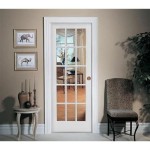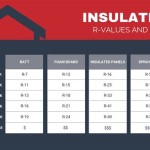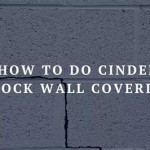What R-Value Insulation is Appropriate for Interior Walls?
Determining the appropriate R-value for insulation in interior walls often involves navigating a range of considerations beyond simple thermal performance. While exterior walls primarily focus on resisting heat transfer to maintain a comfortable and energy-efficient building envelope, interior walls serve different, though equally important, functions. These can include sound dampening, fire resistance, and even enhancing the structural integrity of the building. Consequently, selecting the optimal R-value for interior walls requires a nuanced understanding of these diverse performance goals and how they interact with the specific characteristics of the building and its occupants.
R-value, or resistance value, is a measure of thermal resistance. It indicates how well a material resists the conductive flow of heat. A higher R-value signifies greater insulating power. In the context of exterior walls, achieving the highest practical R-value is often a priority to minimize energy consumption for heating and cooling. However, the same principle does not always directly translate to interior walls. The focus often shifts to addressing other considerations that may be more relevant in the internal environment.
Several factors influence the decision-making process when choosing R-value for interior walls. These factors include the intended use of the space, the presence of noise-sensitive areas, the local building codes, and even the potential for moisture accumulation within the wall cavity. This article will explore these factors in detail, providing a comprehensive overview of the considerations involved in selecting the appropriate R-value for interior wall insulation.
Sound Attenuation: A Primary Driver for Interior Wall Insulation
One of the most significant reasons to insulate interior walls is to improve sound attenuation, also known as soundproofing or sound dampening. Noise pollution can significantly impact comfort and productivity levels, particularly in residential or office environments. Insulation acts as a barrier, absorbing sound waves and reducing their transmission through the wall assembly. The effectiveness of insulation in this regard is measured by its Sound Transmission Class (STC) rating. A higher STC rating indicates better soundproofing capabilities.
While R-value primarily measures thermal performance, it is not entirely unrelated to sound attenuation. Materials with higher R-values, such as fiberglass batts or mineral wool, often possess inherent sound-dampening properties due to their fibrous structure, which traps sound waves. However, simply increasing the R-value does not guarantee significant improvements in soundproofing. Density and material composition are equally important. For optimal sound attenuation, materials specifically designed for this purpose, such as soundproof insulation batts or resilient channels, should be considered.
In scenarios where soundproofing is a critical requirement, such as in home theaters, recording studios, or between bedrooms in a multi-family dwelling, focusing solely on R-value is inadequate. Instead, a comprehensive approach that incorporates specialized soundproofing materials and construction techniques is necessary. This might involve using dense insulation materials like cellulose or rockwool, decoupling the wall assembly with resilient channels to minimize vibration transmission, and sealing all gaps and cracks to prevent flanking paths for sound.
Choosing the appropriate R-value for sound attenuation in interior walls involves balancing thermal performance with soundproofing needs. While a higher R-value can contribute to sound reduction, it is not a direct substitute for materials and methods specifically designed for soundproofing. Consulting with an acoustical consultant can be beneficial in complex scenarios to determine the most effective solution for achieving desired sound levels.
Fire Resistance and Building Codes
Another crucial consideration when selecting insulation for interior walls is fire resistance. Building codes often mandate specific fire-resistance ratings for walls, particularly in multi-family dwellings or commercial buildings. These ratings, typically expressed in hours, indicate how long a wall assembly can withstand exposure to fire before structural failure or significant temperature increases on the unexposed side.
Insulation can contribute to the fire resistance of a wall assembly by slowing down the spread of flames and delaying the temperature rise within the wall cavity. Some insulation materials, such as mineral wool, are inherently non-combustible and can significantly improve the fire resistance of a wall. Other materials, like fiberglass, are inherently fire-resistant but may require fire-retardant treatments to meet specific code requirements.
The required R-value for interior walls may be influenced by fire-resistance requirements. In some cases, achieving the necessary fire rating may necessitate using a specific type of insulation with a certain thickness, which can indirectly affect the R-value. For instance, a code might require a one-hour fire-rated wall, and achieving this rating may necessitate using a specific type of mineral wool insulation with a particular R-value.
It is imperative to consult local building codes and fire safety regulations to determine the specific requirements for fire resistance in interior walls. These codes will typically specify the required fire-resistance rating for different types of walls and may also dictate the acceptable types of insulation materials. Choosing insulation solely based on R-value without considering fire-resistance requirements can result in code violations and potentially compromise the safety of the building and its occupants.
Impact of Climate and Moisture Control
While interior walls are generally not exposed to the same weather extremes as exterior walls, climate and moisture control can still play a role in determining the appropriate R-value. In humid climates, moisture can accumulate within wall cavities, leading to mold growth and structural damage. In such cases, selecting insulation materials that are resistant to moisture or that allow for proper ventilation is crucial.
Insulation materials with higher R-values can potentially trap moisture within the wall cavity if not properly installed or if the wall assembly is not adequately sealed. This is because higher R-value insulation can reduce the rate at which moisture evaporates from the wall cavity, potentially leading to prolonged exposure to moisture and increased risk of mold growth. Therefore, in humid climates, it may be prudent to choose insulation materials with lower R-values that allow for better moisture management.
In contrast, in very cold climates, insulating interior walls between heated and unheated spaces, such as between a living room and an unheated garage, can help reduce heat loss and improve energy efficiency. In such cases, selecting insulation with a higher R-value may be justified. However, it is still essential to consider moisture control and ensure that the wall assembly is properly sealed to prevent condensation.
The decision on whether to insulate interior walls based on climate considerations depends on the specific circumstances and the potential for moisture accumulation. In general, in moderate climates with low humidity, the impact of climate on the R-value decision for interior walls is minimal. However, in extreme climates, it is crucial to carefully consider the potential for moisture accumulation and select insulation materials and construction techniques that promote proper moisture management.
In summary, selecting the appropriate R-value for interior walls requires a comprehensive assessment of various factors, including sound attenuation requirements, fire-resistance regulations, and climate considerations. While R-value is an important consideration, it should not be the sole determining factor. It is crucial to consider the specific performance goals for the interior walls and choose insulation materials and construction techniques that effectively address those goals while complying with local building codes and regulations. Seeking professional advice from architects, engineers, or building contractors can be beneficial in making informed decisions and ensuring optimal performance of interior wall insulation.

What R Value Do I Need Johns Manville

Insulation R Values Chart And Buyer Guide
Understanding R Value Jlc
Understanding R Value Jlc

R Value Insulation

The Importance Of Insulation R Values Eco Spray

How Should I Insulate My Home Blog Usa Insulation
Understanding R Value Jlc

Insulation Levels For Cold Hot And Moderate Climates
Understanding R Value Jlc
Related Posts








